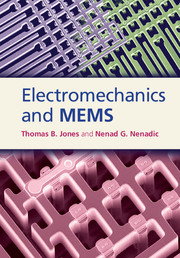Book contents
- Frontmatter
- Contents
- Preface
- 1 Introduction
- 2 Circuit-based modeling
- 3 Capacitive lumped parameter electromechanics
- 4 Small-signal capacitive electromechanical systems
- 5 Capacitive sensing and resonant drive circuits
- 6 Distributed 1-D and 2-D capacitive electromechanical structures
- 7 Practical MEMS devices
- 8 Electromechanics of piezoelectric elements
- 9 Electromechanics of magnetic MEMS devices
- Appendix A Review of quasistatic electromagnetics
- Appendix B Review of mechanical resonators
- Appendix C Micromachining
- Appendix D A brief review of solid mechanics
- Index
- References
Appendix C - Micromachining
Published online by Cambridge University Press: 05 May 2013
- Frontmatter
- Contents
- Preface
- 1 Introduction
- 2 Circuit-based modeling
- 3 Capacitive lumped parameter electromechanics
- 4 Small-signal capacitive electromechanical systems
- 5 Capacitive sensing and resonant drive circuits
- 6 Distributed 1-D and 2-D capacitive electromechanical structures
- 7 Practical MEMS devices
- 8 Electromechanics of piezoelectric elements
- 9 Electromechanics of magnetic MEMS devices
- Appendix A Review of quasistatic electromagnetics
- Appendix B Review of mechanical resonators
- Appendix C Micromachining
- Appendix D A brief review of solid mechanics
- Index
- References
Summary
The field of microsystems has an interesting history. In the late 1950s, the physicist Richard P. Feynman [1] delivered a presentation during which he posed two technological challenges designed to stimulate development of new ways to design and build miniature machines. The first challenge was to write a page of a book on a surface 25 000 times smaller in linear dimensions than the original, to be read by an electron microscope. The second prize was to build a fully functional, miniature, electric motor with dimensions less than 1∕64 of an inch. Surprisingly, the second prize was claimed first in 1960, using conventional fabrication methods. On the other hand, the technology required to accomplish the first challenge did not emerge until 1987. One early MEMS device, the resonant gate transistor shown in Fig. C.1, was demonstrated in 1967 [2], but the field did not really begin to emerge till the 1980s and 1990s. Today there is a vast array of methods and processes for fabricating micromechanical devices. This appendix offers a concise introduction to the fundamental concepts of microfabrication and to the ways it is used to create MEMS devices.
Most of the fabrication processes emerged from the revolution in the microelectronics industry. Those adapted or specifically developed for MEMS are referred to collectively as micromachining. These batch processes have the considerable advantage that they can deliver large numbers of device replicas on a wafer simultaneously.
- Type
- Chapter
- Information
- Electromechanics and MEMS , pp. 498 - 522Publisher: Cambridge University PressPrint publication year: 2013



